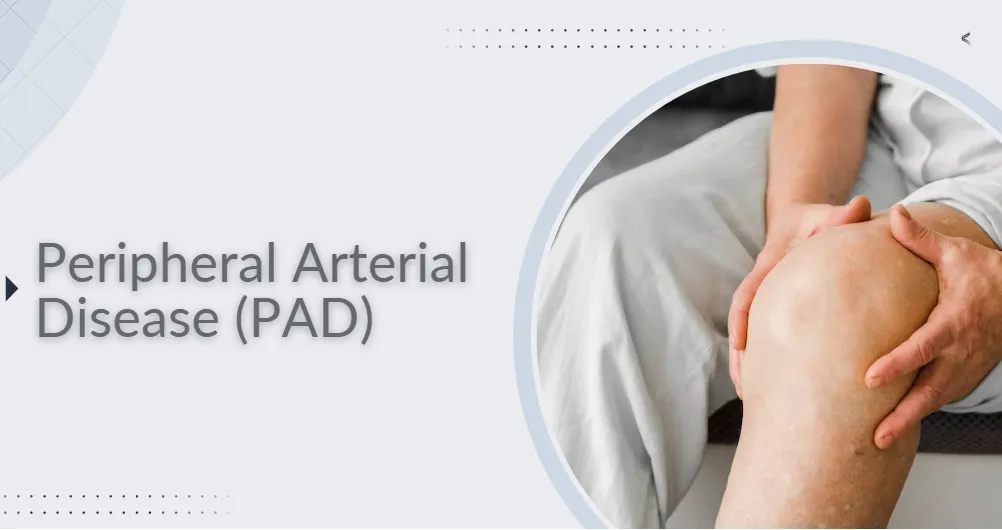Introduction
Understanding Peripheral Arterial Disease (PAD):
1. Definition and overview of PAD
Peripheral Arterial Disease (PAD) is a condition characterized by the narrowing or blockage of arteries that supply blood to the limbs, typically the legs. This narrowing, often caused by a buildup of fatty deposits called plaque, reduces blood flow and oxygen delivery to the affected areas. PAD can result in symptoms such as leg pain, cramping, weakness, and impaired wound healing. Left untreated, PAD can lead to serious complications. It is important to diagnose and manage PAD promptly to improve blood flow, relieve symptoms, and reduce the risk of complications such as limb amputation.
2. Causes and risk factors of PAD
Peripheral Arterial Disease (PAD) can have several causes and risk factors. The primary cause of PAD is atherosclerosis, a condition characterized by the buildup of plaque in the arteries. Plaque consists of fat, cholesterol, calcium, and other substances that narrow and harden the arterial walls, restricting blood flow. Risk factors for developing PAD include smoking, diabetes, high blood pressure, high cholesterol levels, obesity, older age, a family history of PAD or cardiovascular disease, and a sedentary lifestyle. Other factors such as certain medical conditions (e.g., kidney disease) and certain medications (e.g., hormone therapy) may also contribute to the development of PAD.
The Role of Blood Flow and Microcirculation:
Importance of blood flow in maintaining tissue health
Blood flow plays a crucial role in maintaining tissue health throughout the body. Adequate blood flow ensures the delivery of oxygen, nutrients, and immune cells to tissues, while also removing waste products and toxins. Oxygen is essential for cellular metabolism and energy production, enabling tissues to function optimally. Nutrients carried by the blood provide the necessary building blocks for tissue growth, repair, and maintenance. Additionally, blood flow helps regulate temperature, supports immune responses, and facilitates the removal of metabolic byproducts. Insufficient blood flow can lead to tissue damage, impaired healing, and increased susceptibility to infections. Hence, maintaining proper blood flow is vital for overall tissue health and optimal bodily function.
Microcirculation and its impact on peripheral tissues
Blood flow plays a crucial role in maintaining tissue health throughout the body. Adequate blood flow ensures the delivery of oxygen, nutrients, and immune cells to tissues, while also removing waste products and toxins. Oxygen is essential for cellular metabolism and energy production, enabling tissues to function optimally. Nutrients carried by the blood provide the necessary building blocks for tissue growth, repair, and maintenance. Additionally, blood flow helps regulate temperature, supports immune responses, and facilitates the removal of metabolic byproducts. Insufficient blood flow can lead to tissue damage, impaired healing, and increased susceptibility to infections. Hence, maintaining proper blood flow is vital for overall tissue health and optimal bodily function.
Impaired blood flow and its consequences in PAD
Impaired blood flow in Peripheral Arterial Disease (PAD) leads to reduced oxygen and nutrient supply to the affected peripheral tissues. This can result in symptoms such as leg pain, cramping, and weakness. It can also impair wound healing, increase the risk of infections, and in severe cases, lead to tissue damage or limb amputation if left untreated.
Overview of Trental 400mg medication 50 words
Trental 400mg is a medication containing pentoxifylline. It is classified as a peripheral vasodilator and is primarily used to improve blood flow in individuals with conditions such as peripheral arterial disease (PAD). Trental 400mg works by enhancing microcirculation and reducing blood viscosity, leading to improved oxygenation and nutrient delivery to tissues.
What is the Active ingredient in it
pentoxifylline
Mechanism of action and its effects on blood flow
The mechanism of action of Trental 400mg, containing pentoxifylline, involves multiple effects on blood flow. It acts as a vasodilator, relaxing and widening blood vessels, and improving circulation to peripheral tissues. Additionally, it reduces blood viscosity, making blood flow more smoothly through narrowed vessels.
Trental 400mg also exhibits anti-inflammatory properties, reducing inflammation in blood vessel walls and promoting better blood flow. These combined effects contribute to the enhancement of blood flow in individuals with conditions like peripheral arterial disease (PAD), improving oxygenation and nutrient delivery to tissues and potentially alleviating symptoms associated with impaired blood flow.
Benefits of Trental 400mg in PAD Treatment:
Trental 400mg offers several benefits in the treatment of peripheral arterial disease (PAD). By improving blood flow and enhancing microcirculation, it helps alleviate symptoms such as leg pain, cramping, and weakness. Trental 400mg's vasodilatory and anti-inflammatory effects promote better oxygenation and nutrient delivery to peripheral tissues, supporting wound healing and reducing the risk of infections. It may also improve exercise tolerance and walking distance in individuals with PAD. Moreover, Trental 400mg has been found to potentially reduce the need for invasive interventions and improve the overall quality of life for PAD patients.
Administering Trental 400mg:
Recommended dosage and treatment duration
The recommended dosage of Trental 400mg for peripheral arterial disease (PAD) typically involves taking one tablet three times a day with meals. However, the exact dosage and treatment duration may vary based on individual needs and the guidance of a healthcare professional. It is important to follow the prescribed dosage and treatment duration as directed by the healthcare provider for optimal effectiveness and safety.
Potential side effects and precautions
While Trental 400mg is generally well-tolerated, it may cause certain side effects. Common side effects may include gastrointestinal disturbances, such as nausea or stomach discomfort. Less frequently, individuals may experience dizziness, headache, or skin reactions. Precautions should be taken in individuals with bleeding disorders, kidney or liver disease, and those taking anticoagulant medications.
It is important to consult a healthcare professional for a complete list of potential side effects and to discuss any pre-existing conditions or medications to ensure the safe and appropriate use of Trental 400mg.
Interactions with other medications
Trental 400mg may interact with certain medications, and it is important to inform your healthcare provider about all the medications you are taking. It may interact with anticoagulants, antiplatelet drugs, and certain medications metabolized by the liver. Close monitoring and dosage adjustments may be necessary when using Trental 400mg alongside these medications to prevent potential interactions. Always consult with your healthcare provider or pharmacist to ensure the safe and effective use of Trental 400mg in combination with other medications.
Conclusion:
Peripheral Arterial Disease (PAD) poses challenges in maintaining adequate blood flow to the limbs, leading to various symptoms and impairments. Trental 400mg, with its active ingredient pentoxifylline, offers an effective treatment option by improving blood flow, enhancing microcirculation, and alleviating the symptoms associated with PAD. As part of a comprehensive approach to PAD management, Trental 400mg, in conjunction with lifestyle modifications and collaborative healthcare, can significantly improve the quality of life for individuals living with PAD. Consulting with healthcare professionals is essential to determine the suitability of Trental 400mg and to receive personalized guidance for optimal treatment outcomes.
Ref: https://www.cdc.gov/heartdisease/PAD.htm#:~:text=Print-,Peripheral%20Arterial%20Disease%20(PAD),arteries%2C%20which%20is%20called%20atherosclerosis.
https://my.clevelandclinic.org/health/diseases/17357-peripheral-artery-disease-pad








